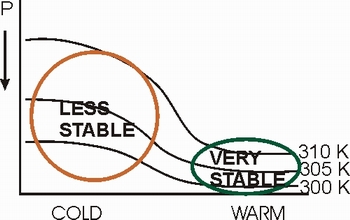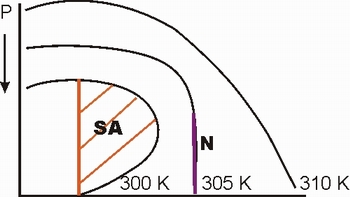Stability
ISENTROPES are the isolines of potential or equivalent potential temperature. For synoptic scale motions, in the absence of diabatic processes, isentropic surfaces are material surfaces. The advantages of analyzing atmospheric processes in isentropic coordinate system are:- the fact that atmospheric variables tend to be better correlated along isentropic surface than on constant pressure surface
- the vertical spacing between isentropic surfaces is a measure of the dry static stability
- the slope of an isentropic surface is directly related to the thermal wind
In the same way that sounding enables us to see the stability of the air column above one point, the cross section of the isentropes gives a quick
overview of the stability of the atmposphere over larger area. The distance between the isentropes is a measure of static stability.
In the following sketches four possible stability regimes are represented:
 |
 |
| Cross-section showing the vertical resolution of the isentropes in a very stable and less stable region. | Cross section showing how isentropic surfaces appear in the regions with superadiabatic or unstable (SA) and neutral (N) lapse rate |
VERY STABLE stratification is chracterized by the high gradient of potential temperature. It is found in the regions of temperature inversion, therefore the most stable area in the troposphere is the TROPOPAUSE.
STABLE are the areas depicted with rather high potential temperature gradient which is often found in the frontal zones, for example.
The regions with superadiabatic lapse rate are UNSTABLE. In these regions potential temperature decreses with height. These are the conditions favourable for convective development!
This are the sketches of the ideal configurations. In the following EXERCISE you can see what the isentropes look like in the real situation
and test your understanding of stability in the cross-sections.